Hanging a plant indoors – Hanging plants indoors has become a popular trend, offering a unique way to add greenery and style to any space. From lush ferns to trailing vines, there are countless options to choose from, each with its own charm and benefits.
Whether you’re a seasoned plant enthusiast or just starting out, this guide will provide you with everything you need to know about hanging plants indoors, from choosing the right plants to proper care and maintenance.
Hanging plants can transform any room, adding a touch of nature and tranquility. They can purify the air, boost mood, and even improve sleep quality. With proper care, these plants can thrive and bring joy for years to come.
Hanging Methods

Indoor plant enthusiasts have a plethora of options to suspend their verdant companions. Each method offers unique advantages and considerations, catering to the size, weight, and aesthetic preferences of the plant and its surroundings.
Hooks and Brackets
Hooks and brackets provide a sturdy and versatile solution for hanging plants. They come in various shapes, sizes, and finishes, allowing for customization to match the décor. Installation is relatively straightforward, involving drilling holes into the wall or ceiling and securely anchoring the hooks or brackets.
However, it’s crucial to ensure proper installation, considering the weight of the plant and the strength of the wall or ceiling.
Macrame
Macrame, the art of knotting cords, offers a bohemian and decorative way to hang plants. Its intricate patterns and customizable designs add a touch of artistry to any space. Macrame hangers are typically suspended from a hook or bracket and can accommodate plants of various sizes and weights.
Hanging Baskets
Hanging baskets are ideal for larger plants or multiple smaller plants. They come in various materials, including wire, wicker, and plastic, and can be suspended from the ceiling or a wall-mounted bracket. Hanging baskets provide ample space for root growth and allow for easy watering and maintenance.
Plant Selection
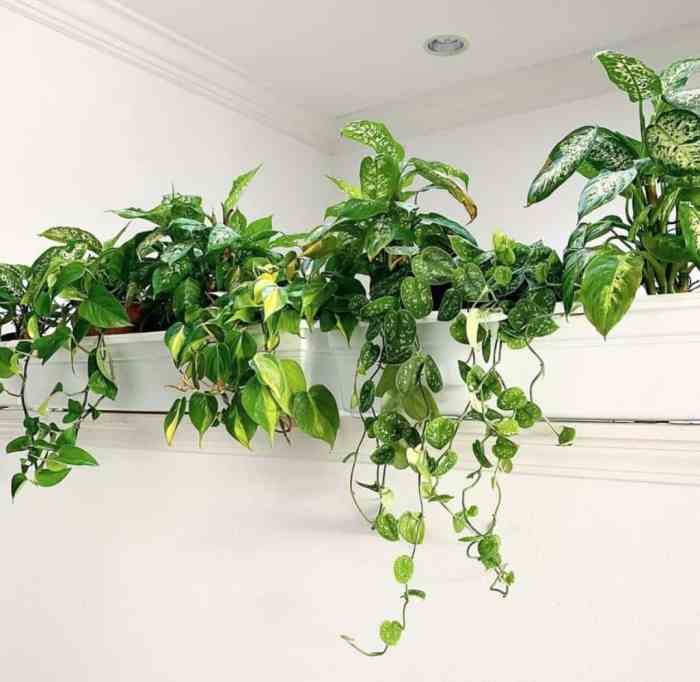
Selecting the right indoor plants for hanging requires careful consideration of several factors, including light requirements, growth habits, and toxicity. Choosing plants that thrive in the specific light conditions of your home is crucial. Additionally, the growth habits of the plant should complement the hanging arrangement, and non-toxic varieties are essential for households with pets or children.
Recommended Plants
- Pothos (Epipremnum aureum):Low-maintenance plant that tolerates low light conditions and infrequent watering. Available in various leaf colors and patterns.
- Spider Plant (Chlorophytum comosum):Produces long, trailing vines with variegated leaves. Prefers bright indirect light and moderate watering.
- String of Pearls (Senecio rowleyanus):Delicate, trailing succulent with bead-like leaves. Requires well-draining soil and infrequent watering.
- Burro’s Tail (Sedum morganianum):Succulent with trailing stems and plump, teardrop-shaped leaves. Thrives in bright indirect light and infrequent watering.
- Heartleaf Philodendron (Philodendron scandens):Heart-shaped leaves with trailing vines. Prefers moderate light and regular watering.
Aesthetic Considerations
Beyond practical factors, the aesthetic appeal of the plant is also important. Consider the foliage, flower colors, and overall appearance of the plant to create a visually pleasing display. Variegated leaves, colorful blooms, and unique textures can add interest and complement the decor of the room.
Location and Lighting
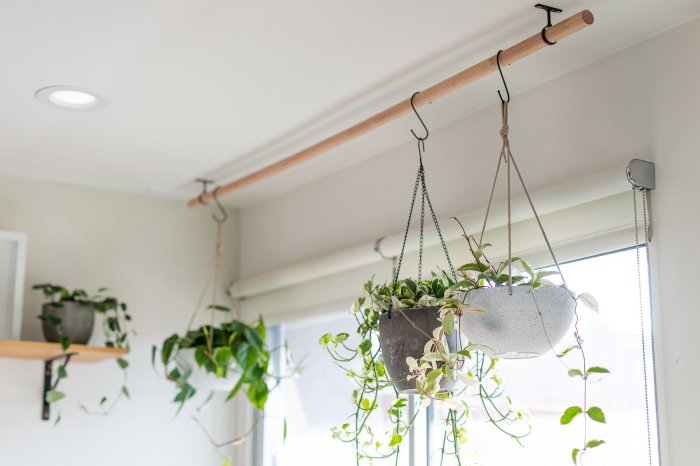
Determining the ideal locations for hanging plants indoors is crucial to ensure their health and aesthetic appeal. Natural light availability and airflow play a significant role in plant growth and well-being.
Assessing light conditions is essential. Observe the natural light patterns in your home throughout the day. Identify areas that receive bright, indirect light for most of the day. Avoid placing plants in direct sunlight, as this can scorch leaves and damage the plant.
Hanging a plant indoors can bring life and color to any room. For those seeking a low-maintenance option, the golden pothos is an excellent choice. Golden pothos hanging plant care is relatively simple, making it a popular choice for both novice and experienced plant enthusiasts.
When hanging a plant indoors, consider factors such as light, watering, and pot size to ensure optimal growth and longevity.
Artificial Lighting
If natural light is limited, consider using artificial lighting to supplement. LED grow lights are an energy-efficient option that provides plants with the necessary spectrum of light for photosynthesis. Place grow lights 6-12 inches above the plant canopy and adjust the height as the plant grows.
Hanging a plant indoors can add a touch of nature to any room. If you’re looking for a plant that will grow quickly and trail beautifully, consider a fast growing trailing house plant. These plants are perfect for hanging baskets or pots, and they can add a lush, cascading effect to your home.
Some popular fast growing trailing house plants include pothos, philodendron, and spider plants. You can find more information about these plants and other fast growing trailing house plants at hangingplantsindoor.com .
Watering and Maintenance
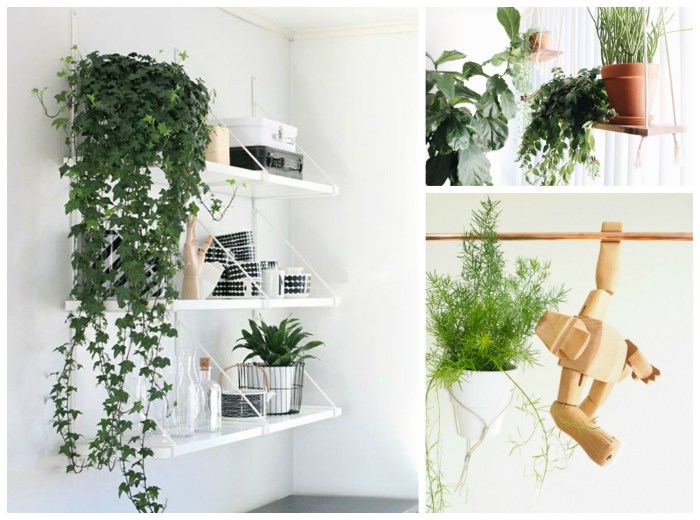
Maintaining hanging plants requires attention to watering, fertilizing, pruning, and repotting to ensure their health and vitality.
Watering:Hanging plants generally have lower water requirements than ground-level plants. Water when the top inch of soil feels dry to the touch. Avoid overwatering, as it can lead to root rot. Use room-temperature water and allow excess water to drain out of the pot.
Fertilizing
Fertilize hanging plants monthly during the growing season with a balanced liquid fertilizer diluted to half strength. Avoid over-fertilizing, as it can burn the roots.
Hanging a plant indoors can bring life and beauty to any room. For those looking to add a touch of elegance, the Garden Reflections 18 Cascading Indoor Outdoor Hanging Basket is a perfect choice. This stunning basket features 18 cascading chains adorned with lush greenery, creating a breathtaking focal point.
Whether you choose to hang it indoors or outdoors, this hanging basket will elevate any space with its timeless charm and verdant beauty, making it an ideal way to bring the outdoors in.
Pruning
Prune hanging plants as needed to remove dead or damaged leaves, control growth, and encourage bushier plants. Use sharp, clean shears to make precise cuts.
Repotting
Repot hanging plants when they become rootbound, typically every 2-3 years. Use a well-draining potting mix and a pot that is slightly larger than the previous one.
Common Problems
Hanging plants may encounter problems such as pests, diseases, and yellowing leaves. Check plants regularly for pests and treat infestations promptly. Address diseases by removing affected leaves and applying fungicides if necessary. Yellowing leaves can indicate nutrient deficiencies, overwatering, or insufficient light.
Aesthetic Considerations: Hanging A Plant Indoors
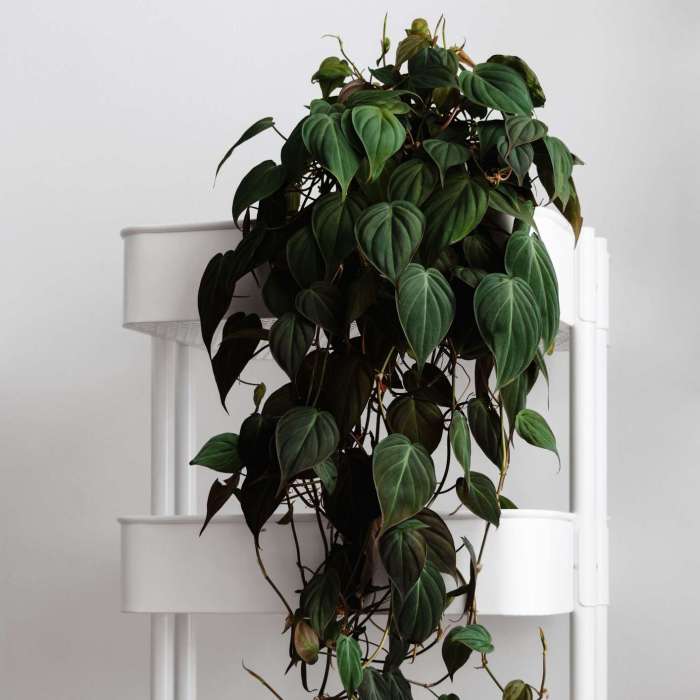
Incorporating hanging plants into indoor spaces offers an opportunity to enhance aesthetics and create a tranquil ambiance. These versatile decorative elements add texture, color, and a touch of nature to any room.
Hanging Plant Styles
| Style | Description | Inspiration |
|---|---|---|
| Boho | Macrame hangers, woven baskets, and trailing plants create a bohemian vibe. | Hang a variety of plants from the ceiling or wall, using different hanger styles and lengths. |
| Modern | Sleek lines, metallic accents, and geometric shapes define modern hanging plants. | Choose plants with clean, architectural forms and display them in metal or ceramic hangers. |
| Minimalist | Simplicity and functionality are key in minimalist hanging plants. | Hang a single plant in a plain, understated hanger to create a focal point without overwhelming the space. |
| Rustic | Natural materials such as wood, jute, and terracotta create a rustic charm. | Use hanging planters made from weathered wood or woven jute and fill them with trailing plants like ivy or ferns. |
Incorporating Hanging Plants into Room Designs
Hanging plants can be used to create various arrangements and combinations in different room designs:
- Create a vertical garden:Hang multiple plants at different heights on a wall to create a lush, vertical display.
- Add a touch of greenery to a corner:Hang a single plant in a corner to bring life to an empty space.
- Use as a room divider:Hang a group of plants from the ceiling to separate different areas of a room.
- Create a focal point:Hang a large, statement plant in a prominent location to draw attention.
- Enhance privacy:Hang plants in front of windows or doors to provide privacy and filter light.
Decorative Elements, Hanging a plant indoors
Hanging plants serve as versatile decorative elements that enhance the overall ambiance of indoor spaces:
- Add texture:Plants with different leaf shapes and textures create visual interest and depth.
- Bring in color:Plants with colorful foliage or flowers add pops of color and brighten up a room.
- Create a sense of tranquility:The presence of plants has been shown to reduce stress and promote relaxation.
Ending Remarks
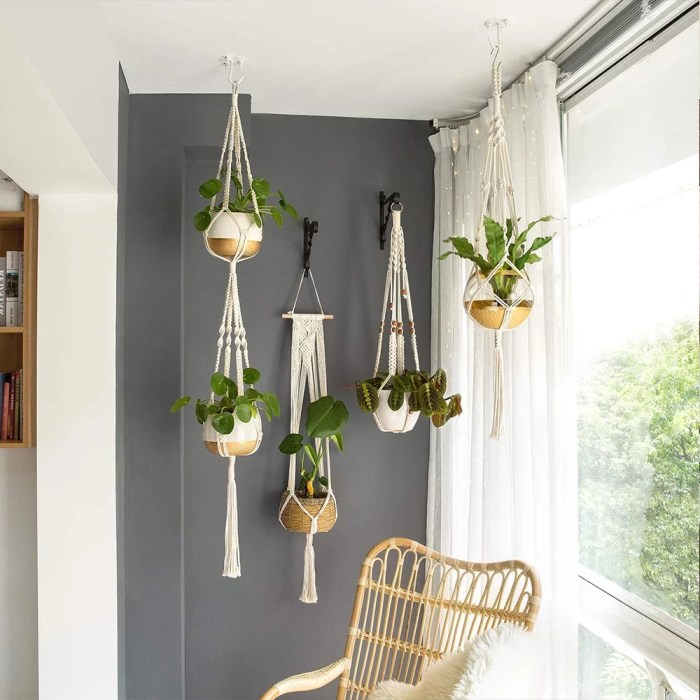
In conclusion, hanging plants indoors is a simple yet effective way to enhance the beauty and well-being of your living space. By following the tips and techniques Artikeld in this guide, you can create a thriving indoor garden that will bring you years of enjoyment and tranquility.
User Queries
How often should I water my hanging plants?
The watering frequency will vary depending on the type of plant, the size of the pot, and the humidity of your home. As a general rule, water your plants when the top inch of soil feels dry to the touch.
What are some common problems with hanging plants?
Some common problems with hanging plants include yellowing leaves, pests, and root rot. Yellowing leaves can be caused by overwatering, underwatering, or lack of sunlight. Pests can be treated with insecticidal soap or neem oil. Root rot can be prevented by ensuring that the pot has drainage holes and that you are not overwatering.
Can I hang plants in my bathroom?
Yes, you can hang plants in your bathroom, but it is important to choose plants that can tolerate high humidity. Some good options include ferns, orchids, and air plants.